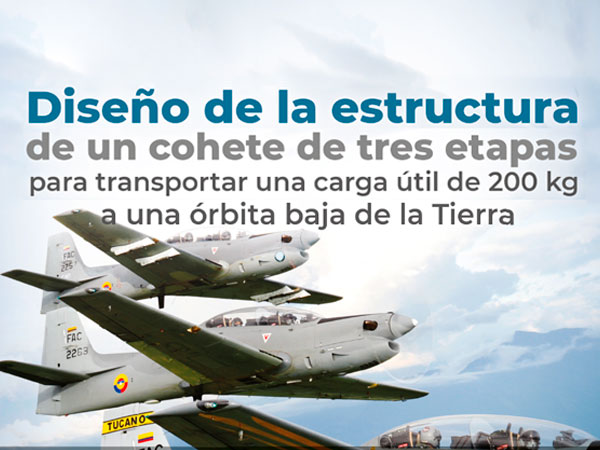Design of the Structure of a Three-stage Rocket to Transport a 200-kg Payload into a Low Earth Orbit
DOI:
https://doi.org/10.18667/cienciaypoderaereo.627Keywords:
Area, Bulkhead, Effort, Inertial Moment, Stringer, ThicknessAbstract
This article presents the conceptual design of the structure of a three-stage rocket capable of carrying 200 kg to low Earth orbits, developed in the project of grade of two students of aeronautical engineering from the Fundación Universitaria Los Libertadores. The design starts from the decision of how they are going to form the structure to protect three rocket engines inside, considering the force generated by the first one since this is the largest, followed by the design of the profiles that make up the structure and selection of a lightweight material such as aluminum (Al) to support efforts up to 280 N/mm2, hence the calculation of total area, the required areas and moments of inertia, begins with the calculation of the stringer profile, followed by the bulkhead profile and even the rivet diameter obtaining dimensioning, structural distribution and the final configuration of the structure.
Downloads
References
Ospina D., y Roldan, L.C. (2013). "Diseño conceptual y preliminar de un cohete de tres etapas de propelente sólido para transportar una carga útil de 200 kg a una órbita baja de la tierra", proyecto de grado, Ingeniería Aeronáutica, Fundación Universitaria Los Libertadores, Bogotá D. C., Colombia.
Huba, O. (1999). "Manuscrito de cátedra parte 2", Universidad de Aachen Instituto de Construcción Liviana.
Gravenhorst, (2017). "Manuscrito de cátedra sistemas de transporte espacial y propulsión espacial", Bogotá D. C., Colombia.
Calderón O., y Murcia, J. (2009) "Diseño conceptual y preliminar de un vehículo que transporta carga útil de una tonelada desde la superficie de la tierra a órbitas bajas", tesis de grado en Ingeniería Aeronáutica, Fundación Universitaria Los Libertadores, Bogotá D. C., Colombia.
Murcia, J.P., (2009) "Estudio de la trayectoria de un cohete de tres etapas lanzado desde el territorio Colombiano" [tesis de maestría], Facultad de Ciencias, Universidad Nacional de Colombia, Bogotá D. C., Colombia.

Downloads
Published
Issue
Section
License
Assignment of Copyrights
Authors assign Ciencia y Poder Aéreo journal the exclusive rights (reproduction, distribution, public communication, and transformation) to exploit and commercialize their work, in whole or in part, in all the formats and modalities of present or future exploitation, in all languages, throughout the life of the work and throughout the world.
All contents published in Ciencia y Poder Aéreo journal are licensed under a Creative Commons Attribution 4.0 International License, whose complete information is available at http://creativecommons.org/licenses/by/4.0/
Under the terms of this license, users are free to download, print, extract, archive, distribute and publicly communicate the content of articles, provided that proper credit is granted to authors and Ciencia y Poder Aéreo, scientific journal of the Graduate School of the Colombian Air Force. Except when otherwise indicated, this site and its contents are licensed under a Creative Commons Attribution 4.0 International License.
For other uses not considered under this license it is required to contact the Director or the Editor of the journal at the e-mail address cienciaypoderaereo1@gmail.com.
The Graduate School of the Colombian Air Force and this publication are not responsible for the concepts expressed in the articles, including the metadata or the affiliation stated by authors. This is the full responsibility of the authors.





















